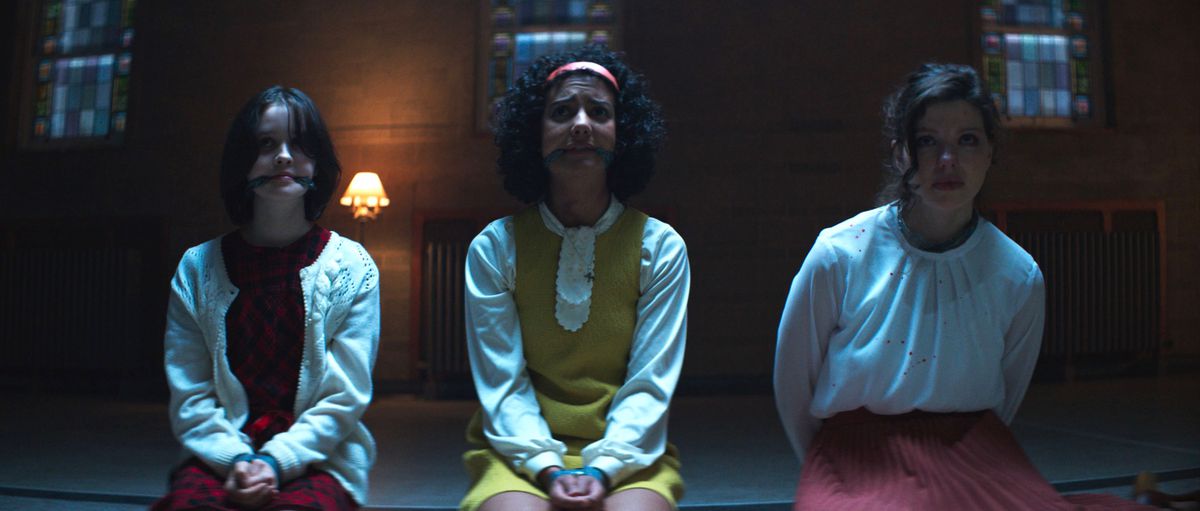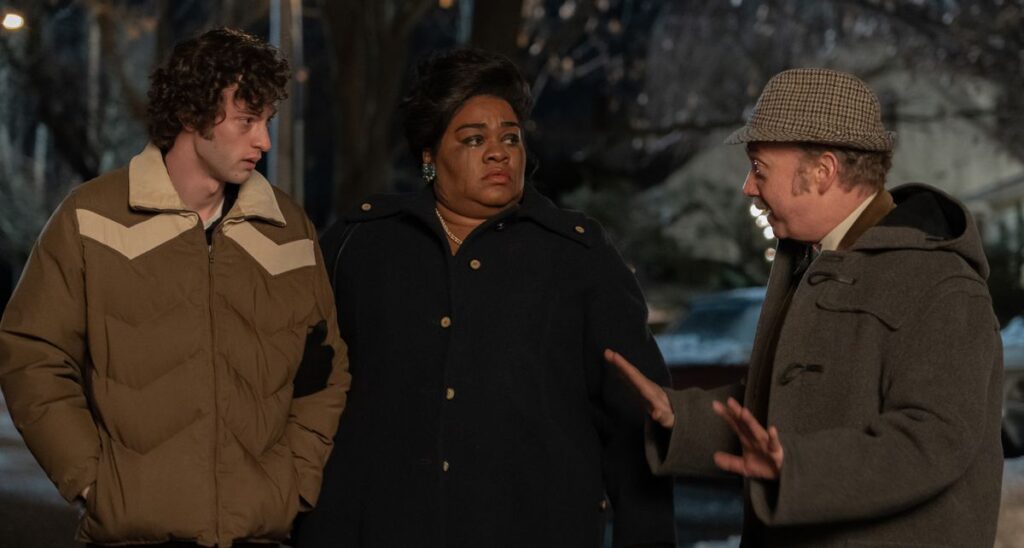When the film world gets one of its unexpected cross-studio theme pairings — the way summer 1998 offered two “impending planetary apocalypse” movies in Armageddon and Deep Impact, or 2022 gave us two major Pinocchio movies — it’s rarely clear on the surface whether the projects stem from corporate copycatting, divergent evolution, or sheer coincidence. Ultimately, it’s rarely worth debating: What matters is whether the films are enjoyable and well-made, and whether they screen better together.
2023’s best strange pairing in that vein is an unexpected one: Alexander Payne’s touching found-family movie The Holdovers and Jenn Wexler’s creepy horror movie The Sacrifice Game, now on Shudder, turn out to be a surprisingly apt double feature — even if they’re using similar plotlines to very different ends.
Both movies are set at Christmas within a year of each other: The Holdovers in 1970, The Sacrifice Game in 1971. Both revolve around remote, single-gender boarding schools, where one unlucky teacher and a few disconsolate students are left behind to make whatever they can out of Christmas break after everyone else heads out for the holidays. Both are built around a series of surprising reveals, as some broad archetypal characters reveal hidden layers and hidden intentions. And both feature those teachers and students making surprising emotional connections with each other.
Only one of them brings in a group of serial killers trying to summon a demon in order to claim its raw, unbridled power, though. Watching the trailers for both movies, it’s easy to guess which one.
What’s particularly enjoyable about watching these two movies back-to-back is that they’re both such warmly well-intentioned movies about the melancholy feeling of being left behind at Christmas, and about finding the spirit of the holiday outside of biological family. In The Holdovers, teenage troublemaker Angus Tully (Dominic Sessa, in a star-making performance) finds out just hours before his planned departure for a family Christmas trip that his mother and her new husband want to spend Christmas alone to build their relationship, and have decided to park him at his elite boarding school for the break. In The Sacrifice Game, Samantha (Madison Baines) has almost the exact same experience: In her case, her mother died in a car accident earlier in the year, and her stepfather is gradually disassociating himself from her, including unexpectedly disinviting her from his holiday plans.
Neither of these young people was expecting to be suddenly discarded by people they considered family, and they each spend their respective movies struggling to throttle down their active disappointment for the sake of basic politeness. Angus is older, angrier, and bolder than Samantha, and he channels his upset over the news much more aggressively than she does. There are other minor differences as well, ones that read as specifically gendered: In The Holdovers, as the teacher responsible for overseeing a small group of jilted students for the holidays, huffy boarding-school prof Paul Hunham (Paul Giamatti) tries to enforce a rigorous regimen of character-building physical activity and study. In The Sacrifice Game, soft-hearted Rose (Chloë Levine) aims more toward placation and comfort for her sad kids.
Photo: Seacia Pavao/Focus Features
And in both cases, these movies complete their central trifecta with a character who helps define the theme. In The Holdovers, it’s Da’Vine Joy Randolph as Mary Lamb, the school’s cook, freshly mourning her son’s recent death in a military misadventure, and giving both Paul and Angus a taste of what real tragedy and an actual dead end look like. They have no way of touching her grief, which puts their own trials into perspective. Samantha and Rose get something similar from Clara (Georgia Acken), a glowering younger girl who avoids friendship and seems to set out to unnerve everyone around her, for reasons that take a while to become clear.
The two films diverge sharply from there, though they both feature crucial road trips. In Sacrifice Game, it’s an inbound group: a foursome of swaggering serial killers, straight out of Quentin Tarantino’s Once Upon a Time in Hollywood, who want to take everyone at the school hostage and use the place as a staging ground for a demonic ritual. In Holdovers, it’s an outbound trip, with Paul, Angus, and Mary leaving the school on an impromptu Christmas Day visit to Boston.
Obviously, these are very different movies. The Holdovers sticks to the prestige-movie path Payne paved the way for with films like Nebraska and The Descendants, with Paul and Angus verbally circling each other, hackles up, until they each start to see what they can gain from dropping their guard. It’s a fairly leisurely movie about opening up, admitting fault and weakness, and trusting other people.
Sacrifice Game, on the other hand, careens briskly through a home-invasion scenario and toward a finale that injects a little comic goofery into what could be a deadly dull grim-’n’-gory bloodbath. Even though it features killers menacing children, a recurring theme of graphic self-mutilation enacted for a variety of reasons (alongside mutilation of innocent victims), and a significant body count, Sacrifice Game is a much lighter movie, in its way.

Image: Shudder
But both films are notable for the way they take their characters’ pretensions and flaws seriously, and the way their scripts find layers of meaning in the characters’ anxieties and the masks they wear around different people. Sacrifice Game’s smug band of murderers are each hiding a lot of personal conflict, which emerges as the tension gets thicker. It’s not all that dissimilar from the way Paul and Angus each have histories they’re lying about, and obvious disguises — the blustering martinet and the behavior-problem bad boy, respectively — they use to deflect any close examination from a world they resent.
These movies are expressly intended for different audiences. There’s a smirk and a wink-wink submerged humor to Sacrifice Game that makes it feel like an in-joke shared with the in-the-know horror audience, while Holdovers feels sincere to a fault, mining its biggest emotional moments out of a sense of its characters brushing the rust and the dust off their little-developed abilities to be kind. Paul and Angus are both awkward people, unpracticed at trust, but heartfelt once they engage it. Sacrifice Game’s sprawling cast mostly heads in the opposite direction.
And yet both of these films also feel like they’re setting out to subvert the idea of the Hallmark Christmas movie — the slick, predictable, poreless comfort-viewing experience where all the beats are obvious from the moment the title hits the screen. They’re both oddball stories about strange and prickly people who can only find their holiday cheer in strange, prickly ways. These movies weren’t made with each other in mind, but they make a fun double feature, both for the sense of cosmic convergence, and for the sense of two teams of moviemakers approaching similar ideas with similar tools, in wildly different ways.
The Holdovers is in theaters and available for premium digital rental now. The Sacrifice Game is streaming exclusively on Shudder.

